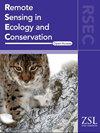物体探测辅助工作流程有助于监测隐蛇
IF 4.3
2区 环境科学与生态学
Q1 ECOLOGY
引用次数: 0
摘要
相机陷阱是研究包括蛇在内的稀有和神秘动物的重要工具。延时摄影对于研究蛇特别有用,因为蛇的变温特性往往无法触发相机的红外运动传感器。然而,延时摄影产生的大型数据集需要劳动密集型分类,限制了它们在大规模研究中的应用。虽然许多基于人工智能的物体检测模型在识别图像中的哺乳动物方面很有效,但它们检测蛇的能力尚未得到证实。在这里,我们使用相机数据来评估物体检测模型快速准确地检测蛇的功效。我们将图像手动分类到物种水平,并将其与混合审查工作流进行比较,其中模型删除空白图像,然后进行手动审查。使用≥0.05的模型置信阈值,我们的混合审查工作流正确识别了94.5%的空白图像,完成图像分类的速度提高了6倍,并且检测到大型(>66 cm)蛇和人工审查。相反,混合审查方法往往不能检测到一串图像中的所有蛇的实例,并且检测到的小蛇(<;66厘米)比人工审查少。然而,大多数相关的生态信息只需要在一系列图像中进行一次检测,研究设计的改变可能会提高对较小蛇的检测。我们的研究结果表明,目标检测辅助混合工作流程可以大大减少人工分类数据的时间-大量的延时蛇研究,并促进对大型蛇的生态监测。本文章由计算机程序翻译,如有差异,请以英文原文为准。
Object detection‐assisted workflow facilitates cryptic snake monitoring
Camera traps are an important tool used to study rare and cryptic animals, including snakes. Time‐lapse photography can be particularly useful for studying snakes that often fail to trigger a camera's infrared motion sensor due to their ectothermic nature. However, the large datasets produced by time‐lapse photography require labor‐intensive classification, limiting their use in large‐scale studies. While many artificial intelligence‐based object detection models are effective at identifying mammals in images, their ability to detect snakes is unproven. Here, we used camera data to evaluate the efficacy of an object detection model to rapidly and accurately detect snakes. We classified images manually to the species level and compared this with a hybrid review workflow where the model removed blank images followed by a manual review. Using a ≥0.05 model confidence threshold, our hybrid review workflow correctly identified 94.5% of blank images, completed image classification 6× faster, and detected large (>66 cm) snakes as well as manual review. Conversely, the hybrid review method often failed to detect all instances of a snake in a string of images and detected fewer small (<66 cm) snakes than manual review. However, most relevant ecological information requires only a single detection in a sequence of images, and study design changes could likely improve the detection of smaller snakes. Our findings suggest that an object detection‐assisted hybrid workflow can greatly reduce time spent manually classifying data‐heavy time‐lapse snake studies and facilitate ecological monitoring for large snakes.
求助全文
通过发布文献求助,成功后即可免费获取论文全文。
去求助
来源期刊

Remote Sensing in Ecology and Conservation
Earth and Planetary Sciences-Computers in Earth Sciences
CiteScore
9.80
自引率
5.50%
发文量
69
审稿时长
18 weeks
期刊介绍:
emote Sensing in Ecology and Conservation provides a forum for rapid, peer-reviewed publication of novel, multidisciplinary research at the interface between remote sensing science and ecology and conservation. The journal prioritizes findings that advance the scientific basis of ecology and conservation, promoting the development of remote-sensing based methods relevant to the management of land use and biological systems at all levels, from populations and species to ecosystems and biomes. The journal defines remote sensing in its broadest sense, including data acquisition by hand-held and fixed ground-based sensors, such as camera traps and acoustic recorders, and sensors on airplanes and satellites. The intended journal’s audience includes ecologists, conservation scientists, policy makers, managers of terrestrial and aquatic systems, remote sensing scientists, and students.
Remote Sensing in Ecology and Conservation is a fully open access journal from Wiley and the Zoological Society of London. Remote sensing has enormous potential as to provide information on the state of, and pressures on, biological diversity and ecosystem services, at multiple spatial and temporal scales. This new publication provides a forum for multidisciplinary research in remote sensing science, ecological research and conservation science.
 求助内容:
求助内容: 应助结果提醒方式:
应助结果提醒方式:


